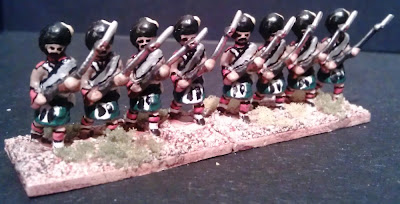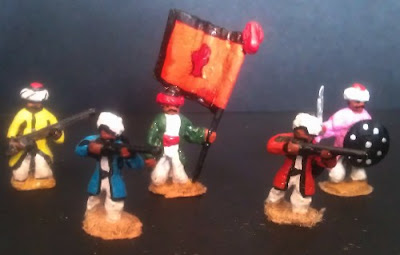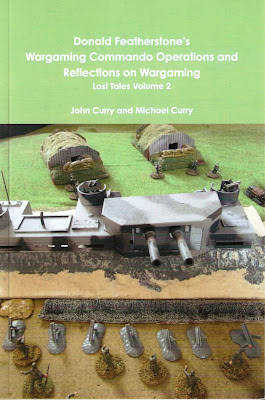During
COW2013 I ran/attended seven sessions ... and what follows is a photo-report of what I saw and did.
Gumbinnen 1914This session was devoted to a recreation of the
Battle of Gumbinnen in 1914. Ian Drury ran the session and used Richard Brooks' OP14 rules, and players were not allowed to deploy their forces onto the tabletop until they could see or could be seen by the enemy.
The battlefield before the session started.
Each player represented a Corps Commander, and they were subordinate to an Army Commander, with whom they could only communicate by written message. The messages were passed to and fro
via a communications umpire, and my role in the game was to act as the Russian Communications Umpire, (The Army Commander was Michael Young, and his Corps Commanders were Tony Hawkins [XX Corps], Peter Grizzell [IV Corps], and Robert Plumb [III Corps]).
One of the innovations Ian introduced into the game was the use of a number of small pinboards, to each of which was attached a map of the battlefield. Each Corps Commander plotted the positions of the units under their command on the map, and this was used by the umpires to adjudicate when opposing and friendly units came into contact.
Peter Grizzell (the commander of Russian IV Corps) using his pinboard map to plot the positions of his troops.
Tony Hawkins (one of the German players) places his Corps on the battlefield. He and the umpire (Nigel Drury) are using the pinboard map to position each of the Corps's units correctly.
The battle is in full swing, and most of the Russian and German Corps Commanders are now sat around the battlefield. The German Army Commander (and his Chief-of-Staff) can be seen in the background, with their backs to the battlefield so that they cannot see what is happening.
Peter Grizzell moves some of his Russian units forward ... and into a swamp!
The Russians ended up losing the battle, but they were out-generaled on the day.
The battlefield at the end of the session.
Operation VijayI ran this session about the Indian 'invasion' of Portuguese Goa in 1961. Each team of players (one each for the Indians and the Portuguese) was given a detailed briefing of the background to the invasions, the forces under their command, and limited intelligence about their opponents. They were then sent off to plan what they were going to do.
The Indians ...
... and the Portuguese.
Once the planning stage was over, each side's plans were gamed through on a large-scale map of Goa, and any fighting was adjudicated by the umpires.
The Indian Army units are advancing whilst Indian Air Force aircraft bomb the only airfield in Goa. Off shore, the Indian Navy is preparing to strike.
The session went very well, and the result was very similar to what actually happened. This was the first time I had ever written and staged such a game ... and I certainly think that it will not be the last.
Fletcher Pratt on GrassThis game was staged by
Wargame Developments Demonstration Team North (i.e. Tim Gow, John Armatys, and Martin Rapier) and was a recreation of a naval action that
should have taken place in the Straits of Gibraltar on 11th September 1940. Three French cruisers, accompanied by three destroyers, passed through the Straits on the way to Dakar in West Africa. The Royal Navy misunderstood where they were going, and failed to stop them as they passed through the Straits. Once the mistake was realised, Royal Navy ships, led by HMS
Renown, set off in pursuit ... but the French got away.
The French squadron.
In this game the British were on the ball, and realised what the French were trying to do ... and sailed out to stop them. The rest, as they say, is history.
To make the best use of the large lawn that is available at Knuston Hall, all the weapon ranges used in Fletcher Pratt's rules were doubled. In order to ensure that it was possible to see the model ships in the grass, they were all mounted on large blocks of wood so that they stood proud of the top of the grass.
Both sides used torpedoes in abundance ... but to little effect!
The War of Freedonian SuccessionJim Wallman organised a wonderful large-scale battle using a slightly simplified version of H G Wells' LITTLE WARS rules. Great fun was had by all ... and we have already decided that we shall stage another battle next year!
The Cordeguayan Army moves forward to assist its allies.
A peaceful hamlet is defended by two units of Infantry.
Two gunboats (FRS Firefly and FRS Cornetto), packed with troops, sail towards the port.
The Flying Column advances overland from the river towards the enemy.
The Infantry of the Flying Column are left behind by the rapid advance of the Cavalry and Motorised Artillery.
The gunboats FRS Firefly and FRS Cornetto.
The landing force disembark from the gunboats and try to advance inland.
One of the Infantry units defending the hamlet. This is a Line Infantry Battalion.
The other Infantry unit defending the hamlet are Guards.
Cordeguayan Cavalry move forward to engage the Flying Column. They are vastly outnumbered ... but they are Cordeguayans and do not know the meaning of fear!
The 'Monster of Walthamstow' (AKA Ian Drury) aims at the advancing Cordeguayans.
After quite a fight the remnants of the landing force begin to advance on the hamlet.
The Cordeguayan Cavalry charge home ... and get wiped out to a man!
The Motorised Artillery of the Flying Column. The driver of the towing vehicle (a Rolls Royce no less!) is a Mr Parker, who is thought to have driven for royalty during his career. It appears that he admits to having been 'at Her Majesty's Pleasure' on several occasions during the past.
Infantry vs. Cavalry: Who will come off worse in this encounter?
The Infantry manage to inflict some casualties, but are forced to retire. Only eight of the original twenty figures remain standing at the end of the melee.
The main body of the Cordeguayan Army arrives at the hamlet.
The two gunboats bring up more reinforcements. At this point both sides agreed a truce.
All the Nice Girls Love a SailorJim Roche's session was based around his father's service in the Royal Navy from 1937 until 1949, and included such wonderful items as
Lieutenant Commander Tommy Woodrooffe's
famous/infamous description of the 1937 Spithead Coronation Review.
Jim Roche and a picture of his father, Paddy.
The session was interspersed with a lot of singing by the attendees, including such famous songs as 'WHAT SHALL WE DO WITH THE DRUNKEN SAILOR?', 'ALL THE NICE GIRLS LOVE A SAILOR' (including the ribald version!), and 'WE'LL MEET AGAIN'. It was a great evening's entertainment!
Ironbottom SoundI had never used any of the versions of the naval wargame rules GENERAL QUARTERS, so I was really looking forward to Ian Drury's session about
the attempts by the Japanese to disrupt the landings at Guadalcanal.
I was given command of a Japanese squadron that was tasked with making a night attack on the invasion fleet. My ships included the heavy cruisers
Atago,
Furutaka,
Kako,
Kinugasa, and
Aoba, the light cruisers
Tenryu and
Yubari, and the destroyer
Yudachi.
We brushed aside the American picket destroyer but later ran into a couple of Allied heavy cruisers and some destroyers, and in the short-range melee that took place both sides suffered losses. In my case my flagship (
Atago) was sunk just after I had handed over control of the squadron to Chris James.
The fighting took place at extremely short range. The white arrows show the tracks of torpedoes.
The Japanese squadron appears to be chasing the off the Allied cruisers. My flagship (Atago) is already on fire (this is indicated by the red counter) and has been hit by at least one torpedo. She sank soon after this photograph was taken.
This was a great battle, and the rules produced a very realistic result in a relatively short time.
Wars and Rumours of WarsThis was a briefing/talk by John Bassett about the possible problems that are likely to affect international relations in the near future.














































